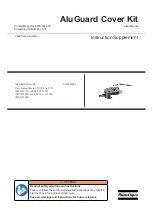
8
CPS 220/64/SV Montage- und Betriebsanleitung
CPS 220/64/SV Mounting and Operating Instructions
8
4. Produktbeschreibung
Die Zentralbatteriesysteme CPS 220 / 20 und CPS 220 / 64
sind ein batteriegestütztes Überwachungs- und Versor-
gungsgerät für den Notlichtbetrieb von Sicherheits- und
Rettungszeichenleuchten. Die im Gerät integrierte und
patentierte Jokertechnik ermöglicht den gleichzeitigen
Betrieb von Dauer- und Bereitschaftsleuchten an einem
Stromkreis.
Eine modulare Aufbauweise und die Möglichkeit, das
System durch Unterstationen und BUS-Unterstationen
zu erweitern, bietet für jede Anforderung eine optimale
Lösung.
4.1 CPS 220 / 64, CPS 220 / 20, CPUS 220 / 64
Die Zentralbatteriegeräte CPS 220 / 64 und CPS 220 / 20
sind mit ihrer integrierten Ladeeinrichtung der Haupt-
bestandteil des Zentralbatteriesystems. Aufbauend auf
diese Gerätetypen kann durch Einsatz der Unterstation
CPUS 220 / 64 die maximal anschließbare Leistung ent-
sprechend erhöht werden.
Der Einsatz unterschiedlicher Stromkreismodule (mit 2A,
4A und 6A), welche wahlweise innerhalb des Gerätes oder
auch extern angeordnet werden können, ermöglicht für
jede Anforderung eine optimale Lösung. Die Versorgung
der externen Stromkreismodule erfolgt über eine gesi-
cherte dreiadrige Versorgungsleitung und eine dreiadrige
Busleitung. Das Stromkreismodul schaltet bei Ausfall der
Busleitung umgehend in den sicheren Betrieb (BL Ein).
Die Schaltungsart für jeden einzelnen Stromkreis kann
über das integrierte Steuerteil frei programmiert werden:
• Dauerlicht
• Bereitschaftslicht
• Geschaltetes Dauerlicht
• Jokerbetrieb
• Geschalteter Jokerbetrieb
Ebenso ist für jeden Stromkreis die Überwachungsart
(Unüberwacht, Stromkreis-, Einzelleuchtenüberwachung)
frei programmierbar. An jedem Stromkreis können bis
zu 20 Leuchten angeschlossen und einzeln überwacht
werden. In der maximalen Ausbaustufe überwacht das
Steuerteil somit bei max. 128 Stromkreisen bis zu 2.560
Leuchten.
Eine Kommunikation der Stromkreise mit den Leuchten
geschieht ohne eine zusätzliche Datenleitung. Bei Joker-
betrieb wird die Schaltungsart (Bereitschafts- oder Dau-
erlicht) an dem Leuchtenmodul über einen Mikroschalter
vergeben. Die entsprechende Leuchtenadresse wird an
den Adressschaltern des Moduls vergeben. Über einen
optionalen Senseeingang am Leuchtenmodul besteht die
Möglichkeit die Leuchten lokal zu schalten.
Die Bedienung der Zentralbatteriesysteme CPS 220 / 64
und CPS 220 / 20, sowie der CPUS 220 / 64 erfolgt über
das integrierte Steuerteil. Je nach Anforderung kann
zwischen einer Version mit vierzeiligem Display für die
Statusinformationen oder einer Komfortversion mit 5,7´´
TFT-Grafik-Display und integrierter USB-Schnittstelle und
Netzwerkanschluss gewählt werden. Die Programmie-
rung des Gerätesteuerteils kann einerseits am Steuerteil
4. Product description
The central battery systems CPS 220/20 and CPS 220/64
are battery-supported monitoring and supply devices
for the emergency lighting operation of safety and emer-
gency exit luminaires. The patented ‘Joker’ technology
integrated into the device enables simultaneous opera-
tion of maintained and non-maintained lighting on one
circuit.
A modular structure and the option of expanding the
system with sub stations and BUS sub stations offer an
optimised solution for every requirement.
4.1 CPS 220/64, CPS 220/20, CPUS 220/64
The central battery devices CPS 220/64 and CPS 220/20,
with their integrated charging system, are the main com-
ponent of the central power system. The use of sub sta-
tion CPUS 220/64 with these device types allows the max-
imum connectable power to be increased accordingly.
The use of various circuit modules (with 2 A, 4 A und 6 A),
which can be arranged either within the device or exter-
nally, offers an optimised solution for every requirement.
The external circuit modules are supplied via a fused
three-wire supply lead and a three-wire BUS data line. If
the BUS data line fails, the circuit module switches to safe
mode (NM On) immediately.
The operation mode for each individual circuit can be
freely programmed via the integrated controller:
• Maintained lighting
• Non-maintained lighting
• Connected maintained lighting
• Joker operation
• Connected Joker operation
For each circuit, the type of monitoring (unmonitored, cir-
cuit monitoring, individual luminaire monitoring) can also
be programmed in accordance with your requirements.
Up to 20 luminaires can be connected to each circuit and
individually monitored. At the maximum expansion stage,
the controller thus monitors up to 2560 luminaires on a
maximum of 128 circuits.
The circuits communicate with the luminaires without an
additional data line. During joker operation, the opera-
tion mode (non-maintained or maintained lighting) is
assigned to the luminaire module via a microswitch.
The corresponding luminaire address is assigned to the
address switches of the module. An optional sense input
on the luminaire module enables the luminaires to be
switched locally.
The central battery systems CPS 220/64 and CPS 220/20,
and the CPUS 220/64, are operated via the integrated
controller. Depending on the requirements, there is a ver-
sion with a four-line display for the status information or a
comfort version with a 5.7" TFT graphic display, integrated
USB interface and network connection. The device con-
troller can be programmed either on the controller itself
or via optional PC software and INOSTICK for controller
with four-line display or USB-Stick for TFT-controller. Each









































